DRAMA/THEATRE
Paper – II
Note : This paper contains fifty (50) objective type questions of two (2) marks each. All questions are compulsory.
1. Match the items in List – I with those in List – II :


2. Assertion (A) : Emile Zola thought many realists were more concerned with theatrical effectiveness than with truth to life.
Reason (R) : Naturalism, unlike realism, had great success in the theatre, probably because it was too liberal in its demands.
Codes :
(1) (A) is false and (R) is true.
(2) Both (A) and (R) are false.
(3) (A) is true and (R) is false.
(4) Both (A) and (R) are true.
3. Give the correct sequence of the following theatre departments from youngest to oldest :
(1) Pondicherry University, Osmania University, Shivaji University, Aurangabad University.
(2) Pondicherry University, Aurangabad University,, Osmania University, Shivaji University.
(3) Pondicherry University, Osmania University, Aurangabad University, Shivaji University.
(4) Aurangabad University, Osmania University, Shivaji University, Pondicherry University.
4. Pick the odd one out :
(1) Kuchipudi
(2) Alkap
(3) Pagativesham
(4) Terukkuttu
5. Which one of the following playwrights won both Nobel Prize in Literature and Academy Award for writing ?
(1) Luigi Pirandello
(2) Samuel Beckett
(3) Eugene O’Neill
(4) George Bernard Shaw
6. Match the items in List – I with those in List – II :


7. Assertion (A) : Each particular theatre activity has a particular sociological context, within which its experimentation has to be seen.
Reason (R) : There can be no absolute criteria for experimentation.
Codes :
(1) Both (A) and (R) are true.
(2) Both (A) and (R) are false.
(3) (A) is true, but (R) is false.
(4) (A) is false, but (R) is true.
8. Indicate the correct sequence in the context of geographical origin from North to South :
(1) Lakhon Khol, Zat pwe, Khon, Bangsawan
(2) Bangsawan, Khon, Zat pwe, Lakhon Khol
(3) Zat pwe, Khon, Lakhon Khol, Bangsawan
(4) Bangsawan, Lakhon Khol, Khon, Zat pwe
9. Pick the odd one out :
(1) The Grouch
(2) The Birds
(3) The Clouds
(4) The Frogs
10. According to N–atyash–astra, the text of the play which served as the basis of dialogue was technically called
(1) Lasya
(2) Natya
(3) Pathya
(4) Shravya
11. Match the items in List – I with those in List – II :

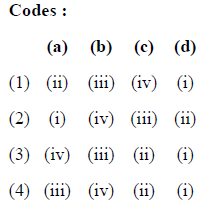
12. Assertion (A) : Today’s folk theatre of Bengal is influenced by contemporary popular media.
Reason (R) : Spectators of folk theatre are getting entertained by television and cinema, which are easily available in remote villages also.
Codes :
(1) Both (A) and (R) are true.
(2) Both (A) and (R) are false.
(3) (A) is true, but (R) is false.
(4) (A) is false, but (R) is true.
13. Pick up the correct sequence of following plays in chronological order :
(1) Oedipus the King, Hedda Gabler, The tragedy of King Lear, The Frogs
(2) Oedipus the King, The tragedy of King Lear, Hedda Gabler, The Frogs
(3) Oedipus the King, The tragedy of King Lear, The Frogs, Hedda Gabler,
(4) Oedipus the King, The Frogs, The tragedy of King Lear, Hedda Gabler.
14. Trace the odd among the following :
(1) Kaku
(2) Sthana
(3) Varna
(4) Vilasa
15. A thin metal template that creates a shadow pattern and rough texture on a desired area of the stage floor :
(1) Thumbnail sketch
(2) Palette
(3) Gobo
(4) Filter
16. Match the items in List – I with those in List – II :

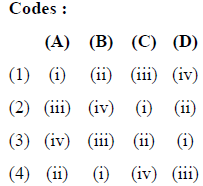
17. Assertion (A) : Meyerhold’s actors presented only the external behaviour of a character by means of acrobatic and athletic movements.
Reason (R) : He considered emotional memory and feeling important for an actor.
Codes :
(1) Both (A) and (R) are true.
(2) Both (A) and (R) are false.
(3) (A) is true, but (R) is false.
(4) (A) is false, but (R) is true.
18. Give the correct sequence of the following Sanskrit playwrights :
(1) Kalidasa, Bhavabhuti, Bhasa, Shudraka
(2) Bhasa, Kalidasa, Shudraka, Bhavabhuti
(3) Shudraka, Bhasa, Bhavabhuti, Kalidasa
(4) Bhavabhuti, Kalidasa, Shudraka, Bhasa
19. Pick the odd one out in context of Elizabethan theatre :
(1) Forestage
(2) Front Curtain
(3) Window Stages
(4) Musicians’ Gallery
20. The concept of ‘Kahani Rangmanch’ is attributed to
(1) Mohan Maharshi
(2) Anuradha Kapoor
(3) Devendra Raj Ankur
(4) Ram Gopal Bajaj
21. Match the items in List – I with those in List – II :

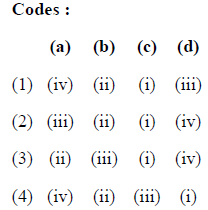
22. Assertion (A) : Tagore treats K–alidasa’s ‘Abhijnan Sh–akuntala’ as the drama of the moral bankruptsy of sensual love and its redemption by suffering and never once refers to ‘Shringara’ or ‘Karuna’ rasa.
Reason (R) : He condemns the hedonism of the courtly ethos depicted in the play as if that ethos had nothing to do with the production of K–avya, its subject matter and treatment.
(1) (A) is true, but (R) is false.
(2) Both (A) and (R) are false.
(3) Both (A) and (R) are true.
(4) (A) is false, (R) is true.
23. Arrange the following Directors in order of their appearance in theatre :
(1) Eugenio Barba, Jacques Copeau, Peter Brook, K. Stanislavsky
(2) Jacques Copeau, K. Stanislavsky, Peter Brook, Eugenio Barba
(3) Jacques Copeau, K. Stanislavsky, Eugenio Barba, Peter Brook
(4) K. Stanislavsky, Jacques Copeau, Peter Brook, Eugenio Barba
24. Trace the odd one out :
(1) Sabse Udas Kavita
(2) Court Marshal
(3) Kaal Kothri
(4) Ek Mamooli Aadmi
25. Sakhi Kundhainata is a puppet theatre, which tells the story of Krishna and Radha. This puppet theatre belongs to
(1) Bengal
(2) Assam
(3) Orissa
(4) Tripura
26. Match the items in List – I with those in List – II :
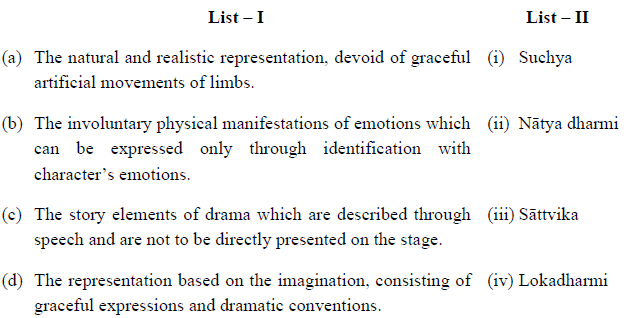
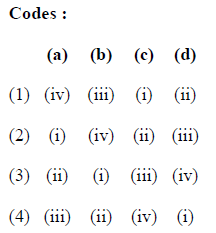
27. Assertion (A) : Within the parameters of the production concept, stage lighting is usually designed to enhance the mood of the play as unobtrusively as possible.
Reason (R) : Creating a mood with light is one of the easiest and, at the same time, most difficult aspects of stage lighting.
Codes :
(1) Both (A) and (R) are true.
(2) Both (A) and (R) are false.
(3) (A) is true and (R) is false.
(4) (A) is false and (R) is true.
28. Give the correct sequence of the following plays of Girish Karnad :
(1) Yayati, Tughlaq, Hayavadana, Naga-Mandala.
(2) Tughlaq, Hayavadana, Yayati, Naga-Mandala.
(3) Yayati, Hayavadana, Naga-Mandala, Tughlaq.
(4) Yayati, Tughlaq, Naga-Mandala, Hayavadana.
29. Pick the odd one out :
(1) Tamasha
(2) Latit
(3) Bharud
(4) Bhavai
30. In which country, Commedia dell’arte developed during Renaissance ?
(1) Italy
(2) England
(3) France
(4) Spain
31. Match the items in List – I with those in List – II :

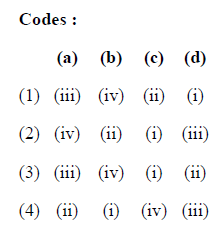
32. Assertion (A) : In Indian context the traditional drama of all modes follows open time structure.
Reason (R) : In a Theatrical performance the lapse of time does not bother the Indian audience.
Codes :
(1) Both (A) and (R) are false.
(2) Both (A) and (R) are true.
(3) (A) is true and (R) is false.
(4) (A) is false and (R) is true.
33. Indicate the correct sequence in the context of geographical origin from North to South :
(1) Bangsawan, Moro-moro, Nat pwe, Peking opera
(2) Peking opera, Nat pwe, Moro-moro, Bangsawan
(3) Nat pwe, Peking opera, Bangsawan, Moro-moro
(4) Moro-moro, Bangsawan, Peking opera, Nat pwe
34. Pick the odd one out :
(1) Dr. Stockmann
(2) Burgomaster
(3) Mrs. Stockmann
(4) Norah
35. It is a single-act Rupaka which is one kind of dramatic monologue :
(1) Vyayoga
(2) Utsrushtikanka
(3) Bhana
(4) Vithi
36. Match the items in List – I with those in List – II :
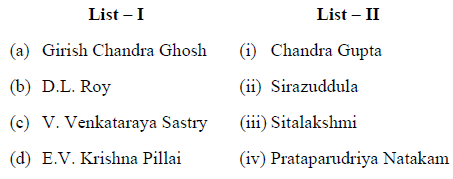

37. Assertion (A) : The culture and theatre of South East Asia must be seen in the context of a long history marked by international contacts.
Reason (R) : Archaeological discoveries have provided increasing evidence of the long history of local cultures and the presence of early civilizations.
Codes :
(1) Both (A) and (R) are true.
(2) Both (A) and (R) are false.
(3) (A) true, (R) false.
(4) (A) false, (R) true.
38. Find the correct sequence according to their development in descending order :
(1) Expressionism, Realism, Romanticism, Classicism
(2) Realism, Expressionism, Romanticism, Classicism
(3) Romanticism, Realism, Expressionism, Classicism
(4) Classicism, Romanticism, Realism, Expressionism
39. Trace the odd among the following :
(1) Vedika
(2) Vatayana
(3) Gavaksha
(4) Parivrutta
40. The Eccyclema, a wheeled platform and pinakes, painted scenery panels were used in :
(1) Elizabethan theatre
(2) Japanese theatre
(3) Globe theatre
(4) Greek theatre
41. Match the items in List – I with those in List – II :
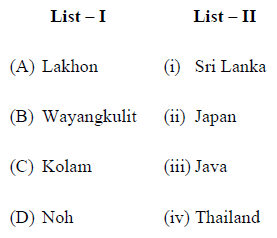
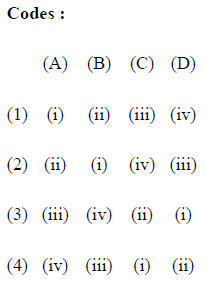
42. Assertion (A) : A majority of the drama performed in the European medieval theatre served with a purpose of reinforcing faith by depicting stories from Bible.
Reason (R) : These plays provided distraction and ‘comic relief’.
Codes :
(1) Both (A) and (R) true.
(2) Both (A) and (R) false.
(3) (A) true, (R) false.
(4) (A) false, (R) true.
43. Give the correct sequence of the following items of Bharata’s ‘Purvaranga’, performed after removing the curtain :
(1) Utthapna, Nandi, Parivartana, Gitavidhi, Trigata
(2) Parivartana, Trigata, Nandi, Gitavidhi, Utthapna
(3) Nandi, Utthapna, Gitavidhi, Trigata, Parivartana
(4) Gitavidhi, Utthapna, Parivartana, Nandi, Trigata
44. Trace the odd one out :
(1) Ellipsoidal Reflector Spotlight
(2) Fresnel Spotlight
(3) Electronic Dimmer Control
(4) PAR Can
45. The play ‘Mahachaitra’ is written by :
(1) Lankesh
(2) H.S. Shiv Prakash
(3) Girish Karnad
(4) Kuvempu
46. Match the items in List – I with those in List – II :
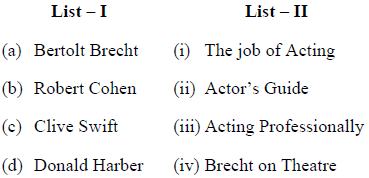
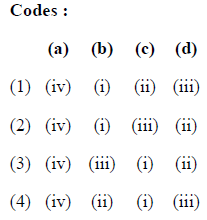
47. Assertion (A) : The Sanskrit dramatist is always interested in the effect on his characters, rather than in the actual incidents themselves.
Reason (R) : Even, in the interludes, he shows this preference by making maid servants and others in a household exchange their reactions to important developments that are occurring.
Codes :
(1) Both (A) and (R) true.
(2) (A) false, (R) true.
(3) Both (A) and (R) are false.
(4) (A) true, (R) false.
48. Arrange the following in a sequential order beginning from down stage to up stage (Front to Back) on a proscenium stage :
(1) Cyclorama, False Proscenium, Grand drape, Grand Valance
(2) Grand Valance, Grand drape, False Proscenium, Cyclorama
(3) Grand drape, Grand valance, False Proscenium, Cyclorama
(4) Grand Valance, Grand drape, Cyclorama, False Proscenium
49. Trace the odd one out :
(1) Ambika
(2) Mallika
(3) Kalidas
(4) Savithri
50. Bhagat is an Indian operatic folk theatre of _______.
(1) Assam
(2) Bengal
(3) Manipur
(4) Uttar Pradesh
Latest Govt Job & Exam Updates: